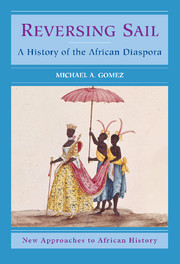3 - Africans and the Islamic World
Summary
We tend to know more about Africans in the Americas than elsewhere in the Diaspora. However, as this chapter makes clear, millions of Africans entered Islamic lands, where they made important contributions to extraordinary civilizations, from the heartlands of the faith to Muslim Spain. An extended discussion of this major component of the African Diaspora is warranted, as the juxtaposition of the similarities and differences between this experience and that of Africans in the Americas yields far greater insight into the condition of displacement than does a lone hemispheric focus.
We begin with a brief consideration of Muḥammad, born circa 570 CE in the city of Mecca, an oasis important as both marketplace and site of religious shrines. Muḥammad was sensitive to the disparities between rich and poor, and his meditations resulted in a series of revelations that began when he was forty years of age; three years later, he began heralding a message centering on the oneness of God, his own role as God's messenger, the Last Day, and the need for a response of submission, gratitude, worship, and social responsibility. Encountering resistance and harassment, Muḥammad and his companions found asylum in Medina, and in 630 they accepted Mecca's peaceful surrender. By the time of his death in 632, the whole of the Arabian peninsula was united under Muḥammad's control. By 656, Islam had expanded into Syria, Iraq, Egypt, and North Africa, and by 711, Muslim armies had conquered parts of the Iberian peninsula as well.
- Type
- Chapter
- Information
- Reversing SailA History of the African Diaspora, pp. 29 - 56Publisher: Cambridge University PressPrint publication year: 2004



